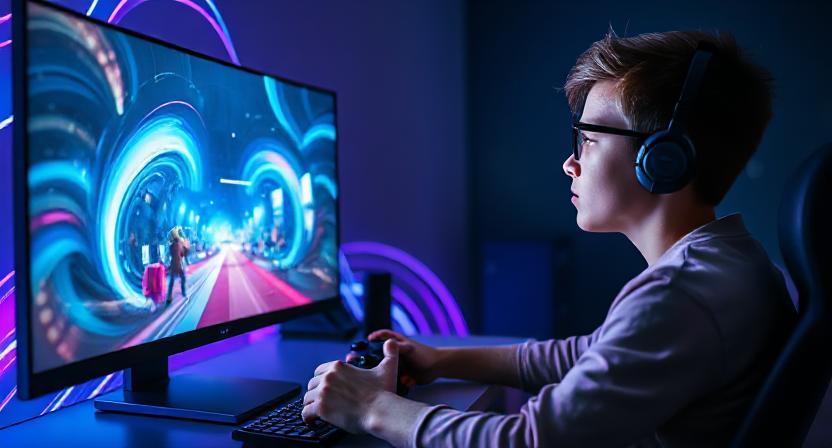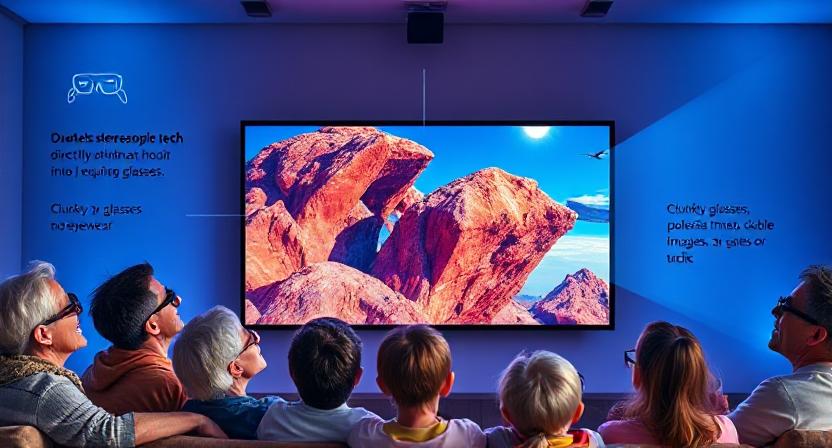Step into Glasses Free 3D Game Without Goggles

The Resurgence of Glasses‑Free 3D Displays in Gaming Monitors and Laptops While 3D screens used to require clunky glasses or bulky headsets, a new wave...
⏱️ Estimated reading time: 5 min
Latest News
The Resurgence of Glasses‑Free 3D Displays in Gaming Monitors and Laptops
While 3D screens used to require clunky glasses or bulky headsets, a new wave of autostereoscopic displays is bringing immersive depth to gaming and creative workflows without any eyewear. Driven by eye tracking, lenticular optics and AI based motion mapping glasses free 3D is finally finding its moment in the gaming hardware spotlight.
The Technology Behind the Depth
Lenticular lenses often combined with real-time eye tracking cameras project two distinct images one for each eye creating a convincing 3D effect without needing glasses. AI-enabled motion prediction helps maintain depth as users move their heads within a limited viewing cone.Ars Technica
Historically early autostereoscopic devices like the Sharp Actius RD3D in 2004 offered such effects, but they were hindered by limited viewing angles low resolution and high cost. The latest generation addresses many of those drawbacks with higher fidelity smoother head tracking and GPU driven rendering.
Key Products Leading the Charge
Announced at Gamescom 2024 and previewed hands on at CES 2025, Samsung’s Odyssey 3D is a flagship 27 and 37 4K QLED display with 165 Hz refresh, 1 ms response time and eye-tracking-enabled glasses‑free 3D. The display supports AMD FreeSync DisplayPort 1.4 and HDMI 2.1. It lets users switch fluidly between 2D and 3D modes. 3D content is converted in real time using view mapping that adapts to your position for realistic depth.
Acer Predator SpatialLabs & SpatialLabs View Monitor
Acer’s SpatialLabs technology integrates a lenticular lens layer atop a 4K panel, combined with stereo eye tracking and SpatialLabs TrueGame software. The Predator Helios 300 SpatialLabs Edition gaming laptop and SpatialLabs View portable 3D monitor support real‑time, rendered 3D for over 50 supported titles. Tom’s Hardware praised it as delivering the best 3D I’ve seen on a glasses‑free device but notes challenges around cost and the need to stay within narrow viewing angles.
ASUS ProArt Studiobook 16 & Vivobook Pro 16X 3D OLED
These laptops bring Spatial Vision ASUS’s glasses‑free 3D OLED tech to creators and gamers. Supported platforms include Unreal Engine Blender Unity and SteamVR. With up to 3.2K resolution 120 Hz refresh and Pantone‑validated color they aim to make 3D creation and previewing seamless. Plus Spatial Vision can support two viewers simultaneously a rarity in this category.
Lenovo Legion 9i 18″ Laptop
Unveiled in early 2025 Lenovo’s Legion 9i boasts an 18 PureSight panel that delivers both 4K 2D and switchable 2K glasses‑free 3D via eye‑tracking and lenticular optics. Paired with an RTX 5090 GPU and Intel Core Ultra 9 CPU the system targets high‑end gamers developers and creators. Among the first supported titles are Cyberpunk 2077 and God of War Ragnarök.

Why It Matters for Gaming and Creativity
3D without glasses removes discomfort, is more natural and is less isolating than earlier stereoscopic methods. It also avoids issues like polarization interference and eye fatigue that plagued active shutter glasses.
Enhanced Visual Realism in Games
With proper support titles can appear layered and immersive, as if objects float off the screen. Consequently complex scenes like top down RPGs or 3D platformers gain an extra dimension. In fact some reviewers compared the depth to a high end Nintendo 3DS experience.
A Tool for Designers and 3D Artists
Notably glasses‑free 3D displays benefit visualization workflows. Artists can preview models animations, and environment layouts in spatial depth directly within their design tools. Moreover software integration via SDKs simplifies that process.
Limitations and Considerations
- Furthermore, these devices target a niche premium market. Price tags often exceed $2,000–3,000 making them appealing mainly to early adopters and professionals not everyday consumers.
- Moreover, these displays have a narrow viewing zone. For optimal results users must remain within a specific distance and angle. Rapid head movements or screen sharing can disrupt the 3D effect.
- Additionally, glasses-free 3D works best with apps and games that include depth maps or native support. Otherwise performance may vary significantly.
- Moreover, extended use can lead to eye strain for some users due to the brain’s continuous focus efforts. Adjusting settings can help but ongoing fine tuning is still necessary.
Applications and Industry Use Cases
Studios and indie devs can preview levels and animations in true depth without VR headsets. It can accelerate design feedback loops and improve spatial game feel.
Content Creation and CAD Design
Architects animators and industrial designers benefit from on-screen real time spatial views of 3D models easing editing and review.
Specialized Gaming Experiences
Certain genres simulators strategy games horror sci fi can gain dramatic immersion. Developers targeting depth awareness may create 3D aware cinematics or UI.
The Future of Glasses‑Free 3D
- Consequently, wider smartphone and tablet adoption is possible as the technology scales down.
- Additionally, AI driven 2D to 3D conversion will expand content compatibility in real time.
- Furthermore, multi‑viewer systems may scale improving collaboration and shared experiences.
- Additionally, with improved refresh rates and resolution next-gen devices may eventually include head mounted displays with glasses free fallback merging VR/AR and flat screen capabilities.
Conclusion
The resurgence of glasses free 3D display technology through companies like Samsung, Acer ASUS and Lenovo is transforming how gamers and creators perceive digital spaces. By combining lenticular optics eye tracking and AI enhancements these devices offer immersive depth without the burden of glasses or VR headsets. Though still premium and niche they signal a future where spatial depth and immersion are standard in personal computing.
For gamers designers and visual creators this new generation of hardware opens doors to experiences once reserved for esoteric hardware or specialized studios. As capabilities improve and content support expands glasses free 3D may become a defining feature of premium gaming and creative tools.
Related Posts
Bluesky Enhances Moderation for Transparency, Better Tracking
Bluesky Updates Moderation Policies for Enhanced Transparency Bluesky, the decentralized social network aiming to compete...
December 11, 2025

Google Maps: Gemini Tips, EV Charger Predictions & More!
Google Maps Gets Smarter: Gemini Tips & EV Updates Google Maps is enhancing user experience...
December 9, 2025

Adobe Acquires Semrush in $1.9B SEO Power Play
Adobe to Acquire Semrush for $1.9 Billion Adobe announced its agreement to acquire the search...
December 1, 2025











Leave a Reply